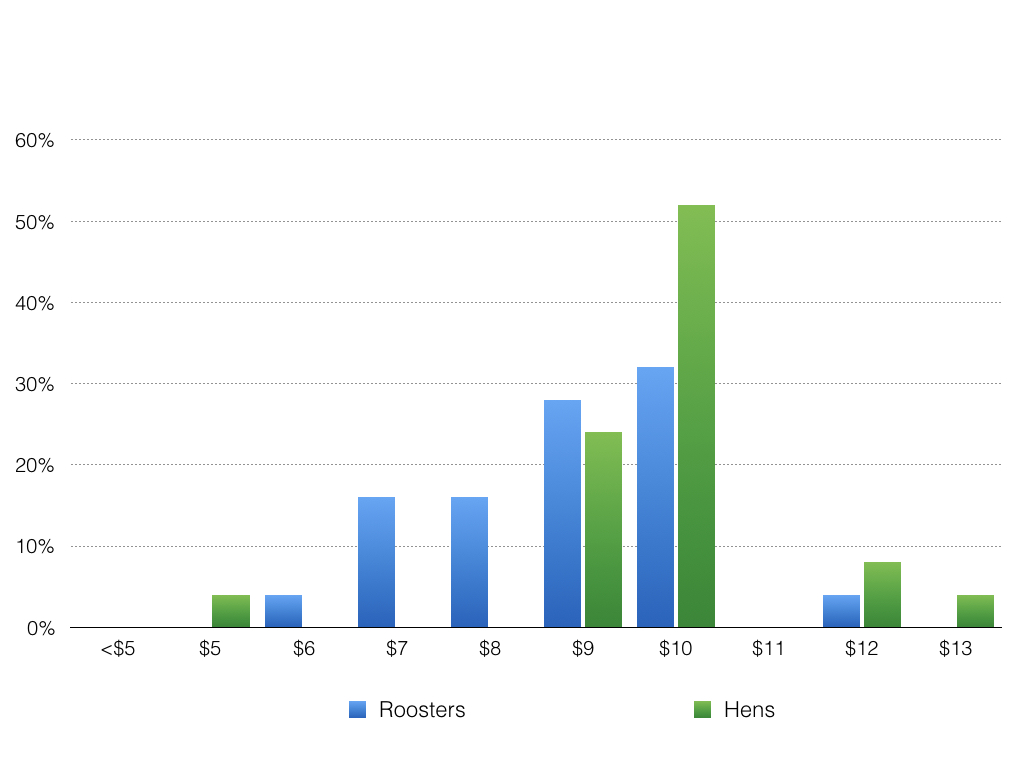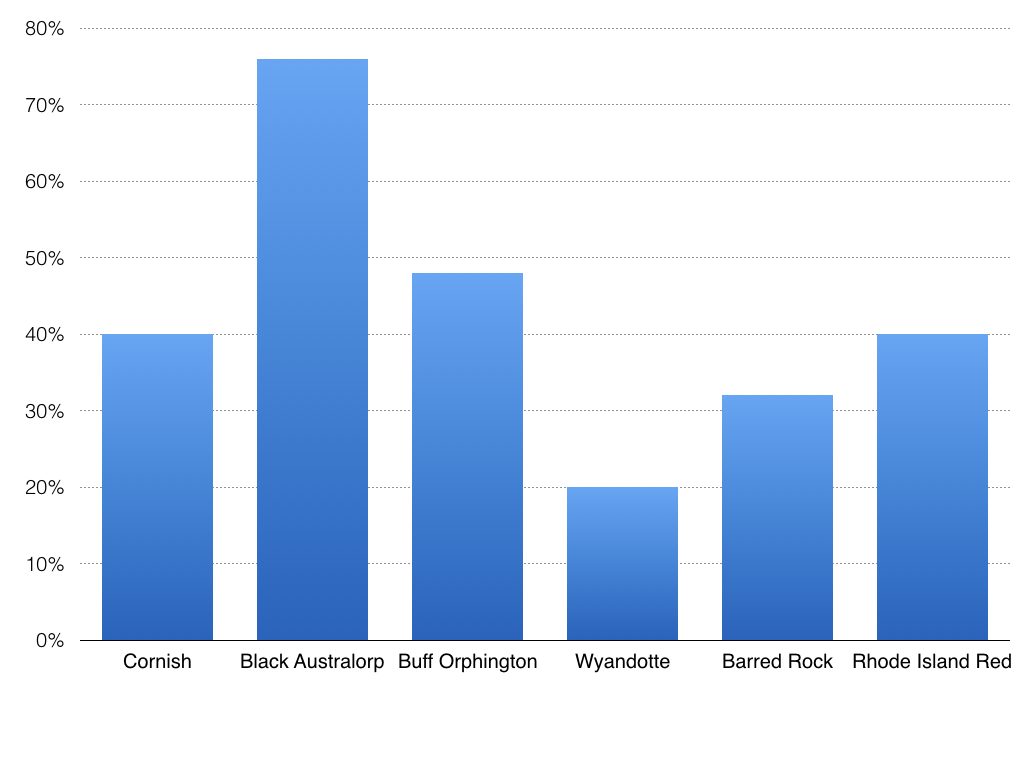Journal of the NACAA
ISSN 2158-9429
Volume 10, Issue 1 - June, 2017
Selling Live Heritage Breed Poultry To Hispanics
- Raab, D., Graduate Student, Kentucky State University
Dasgupta, S., Professor, Kentucky State University
Kelso, J., Research Associate, Kentucky State University
Wright, A. D., Small Farms Agent, Kentucky State University
Bryant, R.C., Research Associate, Kentucky State University
Pescatore, A., Extension Poultry Specialist, University of Kentucky
Jacob, J., Poultry Extension Project Manager, University of Kentucky
ABSTRACT
Heritage breeds of chickens represent a product that might muster a significant demand in ethnic markets. These are standard breeds of chickens that are hatched through natural reproduction, are slow growing, and can live long lives outdoors. This paper reports results of a survey of Hispanic consumers in Kentucky to determine their preferences for heritage chickens. The results showed that Hispanic consumers preferred to purchase live chickens over processed chickens. Of the three heritage breeds available, Hispanic consumers prefer Black Australorps. The average stated willingness to pay was between $8 and $10 per chicken; however, it is unclear if small-scale farmers can be profitable at these prices.
INTRODUCTION
Small-scale farmers are often seeking advice and information from county agricultural agents about new production technologies and niche market availability where they could have a competitive advantage. One area of significant interest is small-scale poultry production. Most Americans are familiar with the taste of fast growing broilers such as the Cornish Cross or Cobb hybrid that vertically-integrated poultry agribusinesses use. Small-scale poultry farmers cannot compete with these large companies but can provide something different to consumers. Heritage breeds of chicken could be one alternative product.
The Livestock Conservancy states that heritage breeds of chicken are American Poultry Association (APA)-defined standard breeds of chickens that are produced via natural mating, are relatively slow growing, and can live long, productive, outdoor lives (The Livestock Conservancy, 2016). When compared to fast-growing broilers, the slower-growing heritage breeds of chickens (called hereafter as “heritage chickens”) are more expensive to produce. However, heritage chickens may have strong demand in local food and ethnic markets, resulting in higher-than-broiler prices that might justify their production.
Hispanic consumers in Kentucky could be potential customers for heritage chickens. Dasgupta et al., (2010) showed that Hispanics in Kentucky have a proclivity for buying live animals for consumption, and are willing to pay premium prices. Given that almost 3.45% of Kentucky’s population are Hispanics (Kentucky State Data Center, 2016), if they were to purchase heritage chickens at premium prices, this market would be ideal for small-scale farmers in the state. This paper represents a pilot study of the opportunities of selling heritage chickens and discusses Hispanic consumers' preferences as determined through direct sales of live chickens. The data presented here were obtained as part of a bigger USDA-funded project related to the production and sales of heritage chickens. Since interviewing potential consumers was essential to this project, an IRB exemption was obtained before the project began.
MATERIALS AND METHODS
During 2015, heritage chickens such as Black Australorp, Barred Plymouth Rock, and Rhode Island Reds, as well as Cornish Cross boilers, grown by the University of Kentucky poultry farm, were advertised for sale at farm-markets in Kentucky that were known to be frequented by Hispanic consumers. When Hispanic consumers purchased the chickens, they were asked to complete a survey questionnaire that elicited details about their preferences for chickens, including information about preferred breeds of chickens, gender of chickens, etc. They were shown color photographs of male and female heritage chickens of five breeds including Wyandottes and Buff Orpingtons in addition to the three listed above and Cornish Cross broilers and were asked to select breeds that they prefer to buy live. Respondents also provided data about at-home food consumption habits and demographics. The data were analyzed to identify trends amongst the consumers.
RESULTS
Twenty-five Hispanic consumers (40% reported as female and 28% reported as male) provided completed survey questionnaires. Their countries of origin were Mexico (12), Guatemala (8), and Honduras (5). Most of them indicated farmer or laborer as the main household occupation. Nearly half of the respondents (48%) were under the age of 30 and over three-fourths (76%) were under the age of 40. The average household size was 4.1. All respondents indicated that they were the principal grocery purchaser for their household.
The survey data indicated that 80% of respondents cooked chicken at home at least once per week. All of the respondents indicated that they were willing to buy live chickens. Figure 1 shows their willingness to pay (WTP) for 5 pound to 10 pound live heritage chickens, separately for adult male chickens (roosters) and adult female chickens (hens). The average WTP was $8.84 per rooster and $9.04 per hen. Mexican respondents were willing to pay $9.08 per rooster or hen; however, non-Mexicans were willing to pay only $8.62 per rooster and $9 per hen.

Figure 1. Willingness to pay for 5-10 pound live roosters and hens.
All of the respondents reported that they were willing to buy live chickens. The majority of the respondents (56%) preferred live hens, while 40% were indifferent to the gender of the birds. Only one respondent preferred live roosters. Of the different cuts of processed chickens that the Hispanic consumers typically bought from retail outlets, whole-dressed birds were popular with 32% of the respondents. Smaller cuts of chicken such as leg quarters, breast quarters, thighs, drumsticks, and breasts were relatively unpopular. Women seemed more willing to buy smaller cuts of chickens than men: five out of 10 women and one out of 7 men reported buying the smaller cuts.
Figure 2 illustrates the respondents’ preferences for breeds of heritage chickens, based on photographs that included fast-growing broilers. The most preferred breed was Australorp, followed by Buff Orpington. The least-preferred heritage chickens were the Wyandottes.

Figure 2. Percentage of the survey respondents showing preference for different breeds of chickens.
CONCLUSIONS
This paper is a pilot study of Hispanic consumers’ perceptions in regards to buying live heritage breeds of chickens. All surveyed Hispanic consumers wanted to buy live birds. Of the different breeds of live chickens, including Cornish broilers, the respondents chose Black Australorp heritage breed of chickens to be their most preferred type. The paper also shows that live hens were more preferred over live roosters, and most of the Hispanic consumers preferred to buy either live or whole-processed chickens.
The average stated willingness to pay for live chickens was $8.84 per rooster and $9.04 per hen. Selling live chickens at these prices is likely to be convenient for farmers because it circumvents costly processing and marketing tasks. However, it is not clear if small-scale farmers can operate profitably by selling heritage breeds of chickens at these prices. This unknown can only be resolved through future production and economics research and on-farm demonstrations.
ACKNOWLEDGEMENTS
Funding for this study was provided by USDA-NIFA-AFRI Award No. 2012-68006-30201. This research has been a cooperative effort between the University of Kentucky and Kentucky State University.
LITERATURE CITED
Dasgupta, S., S. Wesley, and K.R. Probst. (2010). Hispanic Consumer Perception of Kentucky-grown pigs. J. KY Acad. Sci. 71:54-58.
Kentucky Agricultural Statistics. (2011). United States Department of Agriculture: National Agricultural Statistical Service (NASS). Available at: http://www.nass.usda.gov/Statistics_by_State/Kentucky/Publications/Annual_Statistical_Bulletin/B2009/Pg056.pdf
Kentucky State Data Center. (2016). Available at: www.ksdc.louisville.edu/data-downloads/estimates.
Livestock Conservancy. (2016). Available at: http://livestockconservancy.org/
